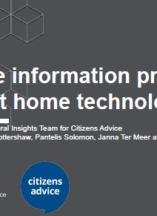The energy market is changing. Decarbonisation and the data revolution are driving the development of new products and services that may significantly changing the way consumers engage with their energy consumption. One result of these developments are complex products like smart battery storage.
These are products that could interact with a household’s energy consumption in different ways – some of which may be unfamiliar to many consumers.
Whether or not a household benefits from using smart battery storage hinges on the interaction of a range of factors. In turn this means, consumers need to pay close attention to whether or not purchasing smart battery storage can actually benefit them. If consumers are to deal with the increasing complexity of the energy market, it is paramount they understand how products like smart battery storage work and that they can rely on industry to provide all necessary information in a simple and accessible way. To that end, Citizens Advice, the statutory body for energy consumers in Great Britain, wants to know what and how much information works, when helping consumers to understand the value of smart appliances like smart battery storage.
This report summarises the results of a research project conducted by the Behavioural Insights Team (BIT) for Citizens Advice to establish an early evidence base for what might constitute effective information provision in the smart battery storage industry.
Key results
We found that overall comprehension improved when we used icons and visuals to illustrate some of the elements conveyed in the product descriptions. All the prototypes improved comprehension of the benefits of smart battery storage, but not of their requirements, although we should note that overall
more participants were able to recall the requirements than the benefits. While the prototypes didn’t improve the understanding of the financial trade-off between the benefits, overall participants grasped this well. A risk warning at the bottom of the product description was effective at making participants
realise that a good purchasing decision in this market should be based on a rigorous cost-benefit calculation involving many individual factors.
At the same time, this risk warning was seemingly so salient that it diverted participant’s attention away from the rest of the information, such as information on the environmental benefit of smart battery storage. The risk warning didn’t influence the proportion of people seeking out more information during the
experiment. The qualitative research revealed that among the three key benefits, participants mainly struggled to understand the mechanisms of signing up to a flexibility service.








